Buddhist Rampage in Burma
Mobs Attack Rakhine Muslim Minority in Potential Ethnic-Cleansing Effort
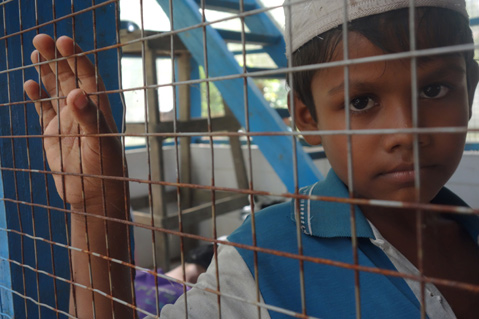
Editor’s Note: In light of the recent UN report about mass killings of Rohingya in Myanmar’s Rakhine state, we are rerunning this 2014 piece from our contributor Kevin McKiernan, who traveled to Myanmar to report on another mass killing of Rohingya in the same region and who was one of the first western journalists to report on these mass killings.
Last month, some weeks after I visited Myanmar, state security forces and Buddhist vigilantes massacred at least 48 ethnic Rohingya Muslims, mostly women and children, according to human rights reports. Witnesses said the mass killings took place in the Rakhine state in western Myanmar — the country also known as Burma — in one of the many areas that are largely off-limits to journalists and humanitarian workers.
Rakhine is the troubled place where in 2012 Buddhist mobs killed more than 200 Muslims and burned thousands of homes. Despite government controls, journalists managed to report that the mobs, assisted by police, had driven more than 100,000 Rohingya into militarized camps. They remain there today, forbidden to marry or to have more than two children without permission or to travel beyond the police and army checkpoints.
Immediately after the massacre, the UN called on Myanmar to investigate. But as with prior atrocities, the government denied responsibility for the killings. According to the Associated Press, on February 27 Myanmar’s government expelled the humanitarian group Doctors Without Borders after the organization reported that it had treated two dozen Rohingya Muslims, victims of violence committed by Buddhist mobs. The government denied the attacks.
I never thought the word Buddhist would be used as an adjective to modify the noun terror.
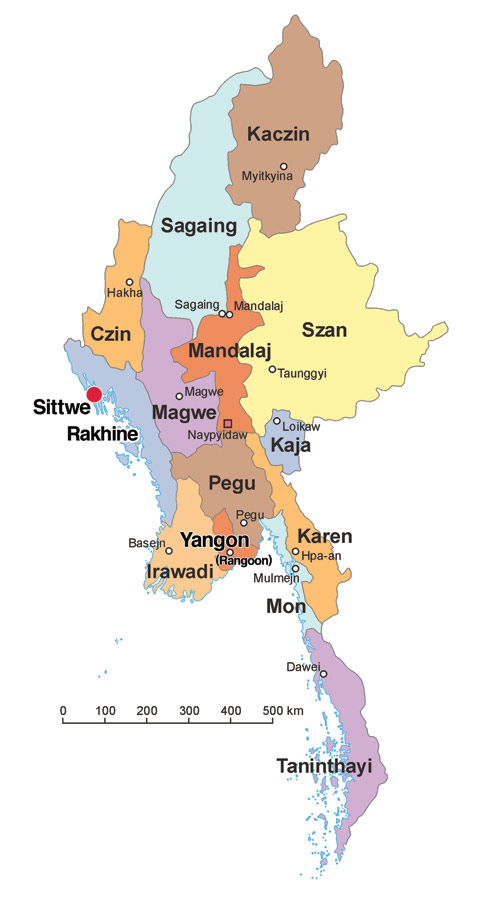
All that changed last summer, when I saw the serene image of a Buddhist monk on the cover of the Asian edition of Time magazine. The story appeared a few months after President Barack Obama’s historic visit to Myanmar, which was intended to note the end of 50 years of brutal military rule and the beginning of a “transition to democracy.” In reality, growing sectarian violence in the country may yet derail that transition, as it may slow down the stampede of Western corporations hungry to share in this, the last frontier market in Asia. Next to the portrait of the monk in his flowing, maroon-colored robes was the headline “THE FACE OF BUDDHIST TERROR.”
Buddhists compose about 90 percent of the population in Myanmar; Muslims account for only about 4 percent. The country has some 135 ethnic groups and a long history of tribal and religious conflict. Founded as a democratic nation in 1948, Burma fell to a military coup in 1962, remaining a dictatorship until 2010. At that time, the junta, desperate for hard currency, announced political reforms and allowed elections, which led to a nominally civilian government. The reforms included the freeing of prominent human-rights activist Aung San Suu Kyi, who had spent 15 years under house arrest in her lakeside home and in the notorious Insein prison. The loosening of military control prompted the lifting of international sanctions, but it was followed by a rash of sectarian violence between Buddhists and Muslims.
Last fall I flew to Burma, the storied home of thousands of golden pagodas and ancient temples. The country was renamed Myanmar by the junta in 1989, but it is still called Burma by many Western nations. I’d reported from China and Vietnam, but somehow I hadn’t realized that this country was as big as Texas, the largest landmass in mainland Southeast Asia.
I certainly didn’t understand what could be at stake for my own country politically — what forging this new alliance might mean for President Obama, whose legacy will be colored, fairly or unfairly, by failures in Afghanistan and Iraq. I guessed that Obama sorely needed a win in the foreign policy column. And I watched with interest, following the visit, when the President lifted punishing economic sanctions, which had isolated Burma as a police state for decades. Now I wondered how these events would impact the beleaguered Rohingya, the people the UN calls one of the most persecuted minorities in the world. Would their sorry tale play a part, however small, in Obama’s legacy?
Or would the Rohingya, these stateless people whose citizenship was revoked when the Burmese generals rewrote the national constitution in 1982, remain a sideshow in a larger picture: the Administration’s attempt to refocus attention from the Middle East toward the China-dominated Pacific, a gambit some have dubbed Obama’s “Asian Pivot”?

Myanmar Stories
It was a humid 93 degrees the morning I landed in Yangon, the city many still call Rangoon (the military changed the name in 1989). Before my trip, Bill Davis, the lead investigator for Physicians for Human Rights, had told me about a Rohingya businessperson called Karim (not his real name), who had moved to Yangon before travel restrictions were imposed. Davis told me that dozens of Muslims had been massacred and 13,000 displaced by mob violence in Meiktila, a town in the center of the country. The mayhem had apparently been triggered by an argument between a Muslim merchant and a Buddhist customer over gold prices. Much of the town had been burnt by Buddhists, who reportedly set fire to the corpses of their victims as police stood idly by. According to Davis, the crowds shouted “Kill the Kalars!” — a racial epithet commonly used against foreigners, despite the fact that many of the victims were from families who had lived in the area for generations. Davis suggested that his contact might be able to take me to see the rubble of the central mosque and school.
Karim was supposed to meet me at the airport, but the roads were choked with the usual autos, pickups, tuk-tuks, and trishaws. He advised me by phone to take the airport van. An hour later, I walked into the lobby of the Queen’s Park Hotel, a reminder of the British colonial period, which ended after Burma declared independence in 1947.
We met in the hotel restaurant where Karim, a well-dressed man in his mid-thirties, selected a table out of earshot of other customers. The breakfast buffet was winding down, and the waiters were removing platters of Burmese delicacies: mango with dried eel and fish bought fresh on the docks only a few blocks from the hotel. Karim began by apologizing that he could not take me to Meiktila. It was just too dangerous. He was willing to help, but only with background information. “I have three little girls,” he said, his voice trailing off.
I knew Myanmar was experiencing the longest-running civil war in the world, a dubious distinction at best. The Burmese army, one of the largest in the world, was now in its sixth decade of fighting ethnic groups, none of them Muslim, on the China and Thai borders. I knew that Burma’s border territories were rich in oil, gas, and precious gems (90 percent of the world’s rubies and the best jade come from here) and that the Burmese military shared in the riches. There was also credible evidence that government-aligned militias were profiting from drug production in Burma’s Golden Triangle, a principal supplier of heroin to the U.S.
During my visit last fall, China completed an oil and gas pipeline from the Bay of Bengal across Burma’s Rakhine state and onward to the Chinese frontier, a distance of more than 1,000 miles. This followed Beijing’s construction of a new railroad from the Chinese border to ports on the Rakhine coast. This was now the fastest way for Chinese products to reach the Indian Ocean. Not to be outdone, a number of American companies had already announced investments in Myanmar, including Coca-Cola, General Electric, and Ford, which was opening its first franchise dealership in Yangon. But the biggest bonanza could be the anticipated influx of post-junta tourists looking for resorts, and many developers were eying properties on the Bay of Bengal. The value of real estate, Rohingya and otherwise, was going up.
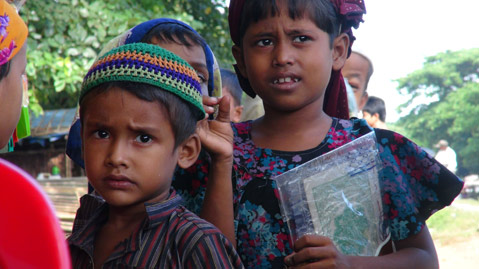
Sittwe
The Rohingyas are a small ethnic minority with their own culture and language, scattered throughout a half-dozen countries from Saudi Arabia to Malaysia. The largest concentration — some 1.2 million — are found in Burma, mostly in the Rakhine state, which lies directly south of Bangladesh on the Bay of Bengal. This is where tens of thousands of Rohingya Muslims were confined “for their own protection” after the attacks of 2012. Sittwe is virtually inaccessible by road, cut off by an inland mountain range, splitting western Myanmar from the rest of the country.
Rakhine was an independent country until 1784, and, in its glory days, European travelers called the coastal kingdom the “Venice of the East.” Despite the fact that today Rohingyas outnumber Buddhists in some areas, ethnic Rakhines still think of themselves as a separate, monolithic people, something similar to the Basques in Spain.
I flew by prop plane to Sittwe, Karim’s birthplace and the Rakhine capital. It’s an island city of almost 200,000, surrounded by rivers that flow into the bay. Sittwe is the spot where the British landed in 1825 during the first Anglo-Burmese War, and, despite a sizeable Muslim population, it is considered the birthplace of “political Buddhism.”
Here in a British security prison in 1939, the monk Sayadaw U Ottama, a famous leader of the Burmese independence movement and practitioner of Theravāda, the oldest surviving form of Buddhism, died on hunger strike. And here in 2007, Sittwe monks launched the “Saffron Revolution,” an uprising against the military government that quickly spread throughout the country but was brutally repressed.
In 2012, the first large-scale sectarian violence broke out in June, when a Buddhist woman was raped and murdered allegedly by three Muslims, who were quickly lynched. It erupted again in October 2012, when the Muslim quarter, Aung Mingalar, was emptied and much of it burned by rampaging mobs. Between the two outbreaks, more than 240 Rohingya Muslims were killed and an estimated 140,000 were confined to internally displaced persons (IDP) camps near Sittwe. Tens of thousands managed to flee the country.
When I tried to get into Aung Mingalar, I was turned back at a police checkpoint. The next day I hired a fixer who got me into one of the camps not far from the ocean. There I met Noor Ali, a Rohingya man in his mid-thirties who was wearing a torn white T-shirt. Ali took me to a makeshift cemetery and showed me a large mound of fresh dirt. It was a mass grave. The day before, Ali told me through an interpreter that the police had come at night in a big truck. Without explanation, they dumped 58 bodies of men, women, and children. The bodies, which were partially decomposed, may have come from another camp, but no one could identify them. The bodies remain a mystery. The police offered no answers, and everyone was too terrified to press the issue.
Ali led me to an older grave in the cemetery. “My wife is buried here,” he said.
We lingered awhile before walking across an open field, lush green and soft from the rainy season that was now ending. He told me his story in simple language. “We used to all live together,” he said of the Sittwe community. “Then one day the monks told [the Muslims] to leave our village. ‘This is not your land,’” they insisted. When his neighborhood leader, who was Buddhist, decided to join the monks, he knew it was time to go. The Muslim quarter was in a state of high panic. During the chaos, Ali was separated from his wife and their 3-year-old boy. “They had to cross a river,” he said, “but the river was too strong.” Ali was only able to find one body, that of his wife.
“They drowned.”
I thought of the Royal Sittwe, the seaside resort beyond the police checkpoints where I would spend the night, one of many that developers hope will transform Myanmar into a tourist mecca. Then I thought of Ali and the others in the camp. They were like random beings adrift in a lawless outer space, where the sound of voices cannot travel. Unhooked from the earthship where most of the rest of us ride, they seemed to be floating away, tinier and tinier in the distance.
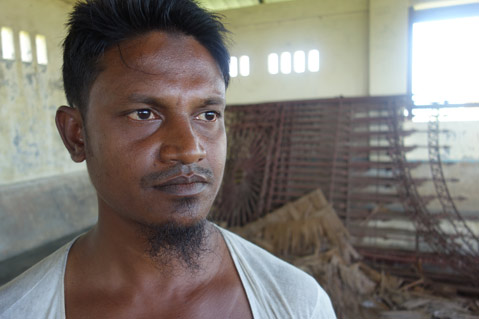
Fleeing Ethnic Cleansing by Sea
On the Bay of Bengal, about a hundred yards from one of the camps, I found what someone generously called the “Rohingya fishing fleet.” The fleet consisted of some 40 wooden hulls, rotten-looking things without a trace of paint. Above the water line, you could see cracks between the swollen planks; below, you could hear the whoosh of bilge pumps working overtime to keep up with the leaks. The boats listed against one other, like huddled driftwood. It felt like a marine graveyard.
On a muddy embankment near the water, several Rohingyas were struggling to revive a boat — it looked more like a skeleton — about 40 feet in length. One man was busy with a hammer, trying to “sister” an old rib with rusty nails. I remembered from my days on the water that salt dissolves iron all too quickly, one reason why wooden boat operators in the West insist on using bronze and stainless steel to fasten planks.
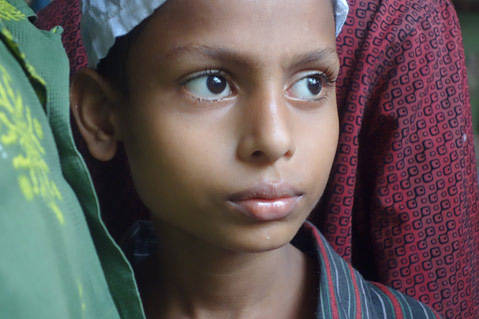
“Sixty or 70 people crowd into these boats,” my guide told me, noting that the rickety vessels do so without any navigational equipment to guide their ocean voyages. Some flee to nearby Bangladesh, he said, others to Malaysia and Thailand.
Just in the last year, according to human rights groups, thousands of desperate refugees had chosen the dangers of ocean escape from the ethnic cleansing. According to the UN, of the 13,000 mostly Rohingya Muslims who fled in 2012, 485 are known to have drowned. Shortly after I left Myanmar last November, 70 men, women, and children drowned when their overloaded boat broke up in the Bay of Bengal.
I had to wonder if the man with the rusty nails was aboard.
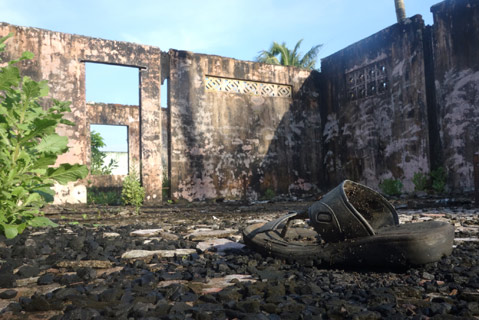
A Burnt Mosque
I followed Aung Win, my balding 60-year-old fixer, through the ashes of the torched mosque near Sittwe and into an adjoining space that used to be a madrassa. Aung Win said that some 350 people had come there every day to pray. We passed through the eerie remains of a classroom, walls still standing, a floor of blackened rubble, then on to the remnants of a kitchen, where student lunches once had been prepared. Plate and teacup fragments cracked underfoot.
“The Buddhists set everything on fire on June 12 and then again on June 13 and 14,” he said. “Then the police attacked the people who were trying to run away.”
We walked to another room, with only walls standing. For a moment we were alone, out of sight of the nearby guards. “During the violence, I lost two of my brothers-in-law,” Aung Win said quietly. “One of them was killed by beating and the other,” he said, dragging a finger across his neck, “his throat was cut with a long knife.”
“I am very sad,” he said, tears welling up in his eyes. “I do not think still there is justice in Myanmar.”
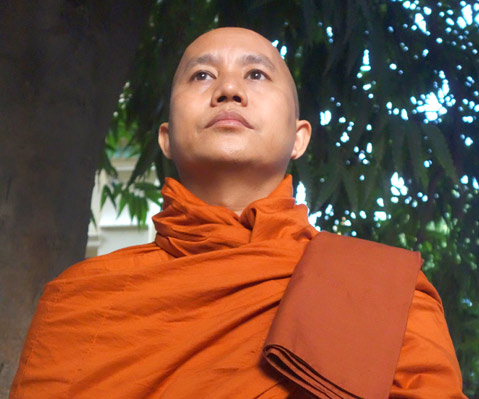
Wirathu
Buddhism and nationalism have been intertwined in Burma for more than a century. It is a good guess that George Orwell, the writer who first came to Burma as a British police officer in the 1920s, witnessed monks taking part in demonstrations against the occupation. And here, almost a century later, was Ashin Wirathu, the radical Burmese monk, notorious leader of the “969” political movement, the anti-Muslim crusade widely condemned for spreading hate speech. In 2003, Wirathu was sentenced to 25 years in prison for inciting riots that led to the killing of 10 Muslims but was released in 2010 in a general amnesty for political prisoners. Considering his volatile history, I was surprised to meet a charismatic, cherubic-looking preacher, a boyish 45-year-old who stood only about 5’7″, with a voice so soft it was difficult to hear.
The 969 movement considers Rohingyas to be land- and job-grabbing illegal immigrants from Bangladesh. They are like “Mexican sneakers in your country,” someone told me, rephrasing a common slur. Wirathu joined 969 — the number supposedly refers to Buddhist scripture — in 2001. The movement’s logo, a circle of light emanating from three lions on a pedestal, can be seen throughout Burma on vendor stalls, taxicabs, and private vehicles. Wirathu has thousands of Facebook followers, and his YouTube videos calling Muslims “dogs” and “carp” and other names are all over the Internet.
I met him at the respected Masoeyein Monastery in the city of Mandalay in central Myanmar, where he presides over some 2,500 monks. Wirathu painted a picture of Buddhist monks cowering under physical threat from a worldwide Muslim conspiracy. “Their purpose is to turn Myanmar into an Islamic state,” he claimed. While most Rohingya are not connected to terrorist groups like Al Qaeda, he said, the majority are bound by their influence.
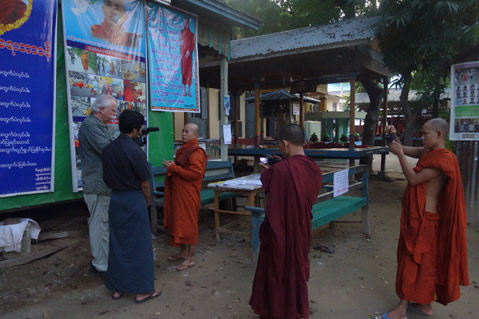
assigned three young monks to shoot photos and video of him.
Outside Wirathu’s temple were two large bulletin boards, where gruesome photos of the corpses of mutilated monks were posted. An idyllic drawing of Wirathu, encircled by the doves of peace, was positioned above the corpses. Wirathu told me the monks were bludgeoned or hacked to death by Muslim attackers. I asked him where the pictures were taken. He said Thailand and Bangladesh, both of which have small Rohingya populations. He later claimed similar photos on the other board were taken in the Rakhine state in Burma, though there was no context for the photos and no authentication. It seemed preposterous to believe that the murders of so many monks could have taken place in a society where the majority population is Buddhist — a place where monks are held in such reverence that they routinely jump queues at supermarkets and airport counters. How could all these crimes be committed in such a country without being reported in the news?
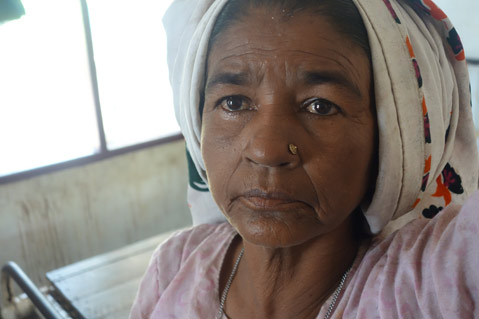
Andrea Gittleman, the senior legislative counsel for the Physicians for Human Rights in Washington, D.C., said her organization has seen a connection between speeches by Wirathu and spikes in anti-Muslim violence across Myanmar. Gittleman cited the example of Wirathu leading a rally of monks in Mandalay in September 2012 to promote the current president Thein Sein’s controversial plan to send Rohingya Muslims to a third country. A month later, more violence broke out in the Rakhine state.
(note: According to Burmese media accounts, the January 2014 massacre in Rakhine erupted soon after monks delivered sermons calling for the expulsion of all the Rohingya.)
In last year’s controversial Time interview, Wirathu took the title “Burmese Bin Laden.” After the exposé, more than a thousand monks and other Burmese attended a protest rally and Deputy Minister of Information Ye Htut banned the magazine, saying it was necessary to halt the spread of “hate speech.” Wirathu was quoted in the article saying Muslims were the main cause of violence in the world, and urging his compatriots to be vigilant: “You can be full of kindness and love, but you cannot sleep next to a mad dog.”
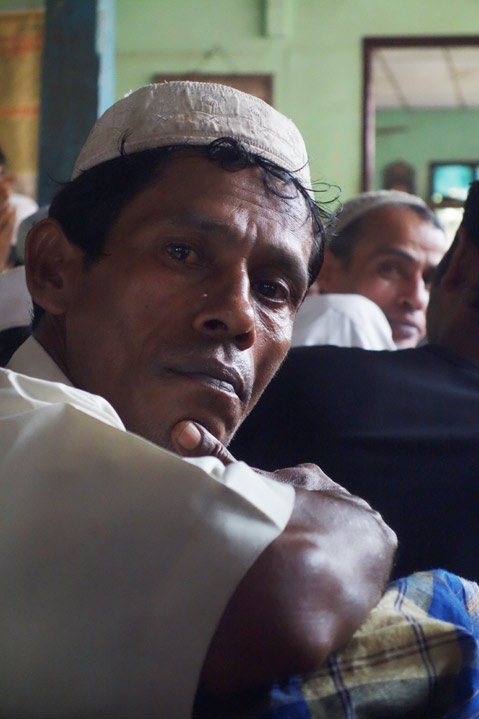
Late in the afternoon of our interview, standing in a sweat-drenched shirt next to the photos of mutilated corpses, I listened as Wirathu began to profess his admiration for historical figures such as Corazón Aquino in the Philippines, Benazir Bhutto in Pakistan, and Mahatma Gandhi in India. “I have a great deal of respect,” Wirathu said, “for a leader like Martin Luther King who has shown us the way for peaceful resistance. There are a few people in Myanmar who follow his example, and I identify with them.”
It all had a weird, Alice in Wonderland feeling. Here I was, an American visitor, now steeped in human rights reports about Buddhist atrocities against Muslims, talking to an angelic little man who claimed that the Rohingyas were behind most, if not all, of the carnage. Why have all these Rohingyas been killed and why were there 140,000 refugees in those camps? I asked incredulously. It’s propaganda, Wirathu replied politely.
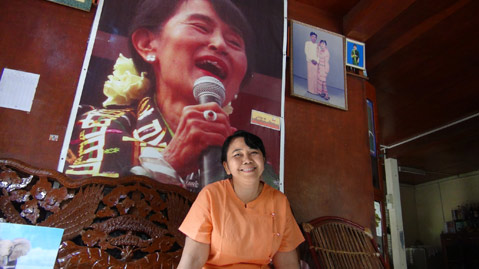
The Buddhist Peacemaker
The first thing that grabs your attention in her tidy middle class house in Mandalay is the large photo of Aung San Suu Kyi, Burma’s famous dissident and Nobel laureate. The home belongs to Armarni Sein Hlaing, a peace activist who, as a student in the ’80s and ’90s, was briefly detained in demonstrations against the military junta and once “spent a month hiding in the jungle” after her college friends were arrested. She told me that in order for Suu Kyi to run for the presidency in 2015 — a development that might convince many skeptics that Myanmar was on a real path to democracy — the military would have to agree to amend the constitution, which states that a candidate’s family must have been born in Burma. Suu Kyi’s husband and children were born in England.
Such a change, Armarni guessed, was unlikely.
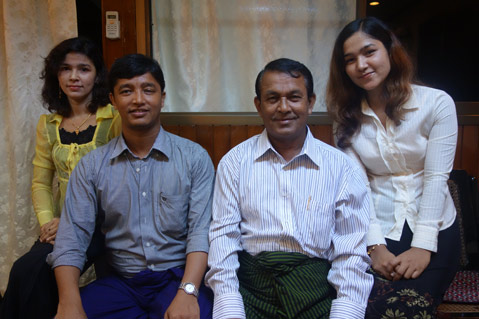
along with his wife and three children, for speaking out for Rohingya.
Today, Armarni and her husband are members of the once-outlawed National League for Democracy, which was represented in the historic election of 2012 when Suu Kyi was elected a member of Parliament. Like Suu Kyi, Armarni and her husband, who is a maritime engineer, are Theravāda Buddhists. They are part of a group called Myitta, which tries to promote harmony between Buddhists and Muslims. Myitta means “empathy” in Burmese.
Armarni said she welcomed the democratic reforms, especially the new press freedoms, but she said the violence against Muslims was orchestrated, “a deliberate attempt by the government to sway the outcome” of the coming elections. The Myitta movement was raising issues I hadn’t heard before, which seemed a hopeful sign. “It is the government that is trying to divert attention to distract us from the real issues at hand,” she said. “There is no reason for the Buddhists and the Muslims to fight — we were all born here and are like brothers and sisters,” she added. But “someone is pulling the strings — there is a puppet master.”
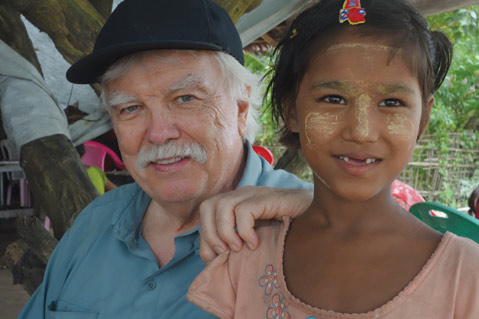
Leaving
On my last day in Myanmar, five bombs exploded in Yangon. In one of the blasts, a 43-year-old American tourist in the Traders Hotel suffered multiple injuries. The government blamed Karen guerrillas, one of an alphabet soup of rebel groups in the resource-rich north, which have been fighting the Burmese army for almost 60 years.
A Yangon newspaper, perhaps testing the limits of the new press freedoms, blamed the Burmese secret police, claiming government efforts to instill fear in the long run-up to the 2015 elections. Given the conspiracy theories swirling in the country, that guess was as good as any.
This was the end of the Buddhist Lent, the religious holiday known as Thadingyut that falls each year when the rains begin to retreat. This year Thadingyut overlapped with Eid al-Adha, the worldwide Islamic feast that honors the sacrifice attributed to the patriarch Abraham. I got a taste of both, first by walking in the annual festival of lights that celebrates Thadingyut. Then Karim picked me up and brought me to the Muslim quarter, where lines of poor people had queued up to receive the traditional donations of lamb.
After that we went to the family home of Kyaw Min, a well-known Rohingya politician who had been elected as a member of the Myanmar Parliament in 1990. In 2006 Kyaw was arrested by the secret police on charges his Rohingya advocacy was giving Myanmar a “bad name” abroad. Then the police rounded up the rest of the family, Kyaw’s wife and their three children. The youngest, Wai Wai (who was 18 at the time), told me the notorious Special Branch police came to their house at midnight. After two months in jail without benefit of counsel, Wai Wai said she and her mother and siblings were sentenced to 17 years in prison. Her father, the real target, was sentenced to 46 years. All of them were incarcerated at Insein, the notorious prison built by the British in 1871. The prison — which, at the time of its construction, was the largest in the Empire — was intended to house 5,000 inmates. Under Myanmar military government, Kyaw said, the population had swollen to 10,000.
Only a few months before my visit, Kyaw and his family were released from prison. Considering their seven-year ordeal behind bars, they struck me as remarkably cheerful.
Kyaw was back at work printing broadsides. His daughter Wai Wai, a bright young woman of 25, had polished her English while in prison and was now virtually fluent. She was taking civics classes at the U.S. Embassy, which had given her and a peace delegation she belonged to coveted visas to visit the U.S. Encouraged by the Americans, she and her delegation had just returned from a trip to New York and Washington, D.C. It was a small but hopeful sign.
Flying home on China Airlines, watching The Lone Ranger with subtitles in Mandarin and eating a kosher meal that had been packaged in Belgium, I had to marvel how the world had shrunk — and how Burma had remained so frozen in time.
A few weeks after I returned to Santa Barbara, the United Nations passed a resolution urging Myanmar to grant citizenship to the disenfranchised Rohingya. Myanmar quickly told the UN to mind its own business (which, some might say, it was trying to do). After that, the U.S. Congress introduced a nonbinding resolution calling on “Burma to end the persecution and discrimination of the Rohingya people and ensure respect for internationally recognized human rights for all ethnic and religious minority groups.” The resolution, which Tom Andrews, former U.S. congressmember from Maine, helped draft, is largely symbolic. It is aimed in part at those in the Obama administration who are pushing behind the scenes for the U.S. to lift the last big sanction, military aid to Burma, which was cut after the bloody crackdown on protesters 25 years ago. “It’s wrong to be talking about weapons,” Andrews told me. “The big question should be whether the Myanmar military is answerable to the government or, as it appears, the government is still answerable to the military.” The overall issue is being driven, the ex-congressmember said, by the U.S. and China vying for power in Burma. “That’s why I fear [U.S. military aid] will eventually pass.”
I asked Andrews why Aung San Suu Kyi, the symbol of human rights in Myanmar who is so revered in Washington, D.C., had remained silent in the face of the brutal ethnic cleansing of the Rohingya. “Muslims are the third rail of politics,” he said bluntly.
“No politician in Burma can make a stand for a reviled minority and still be elected.”
Kevin McKiernan is a journalist and filmmaker. He directed the PBS documentary Good Kurds, Bad Kurds and is the author of the book The Kurds: A People in Search of Their Homeland (St. Martin’s Press, 2006). Find a link to his video documentary, ‘Ethnic Cleansing in Burma’ here.



